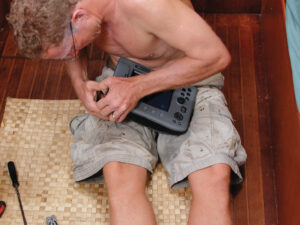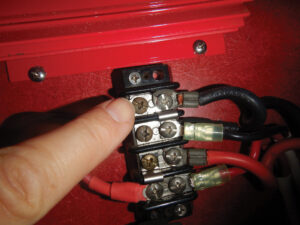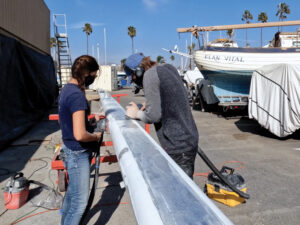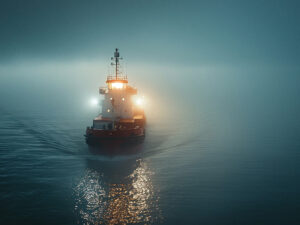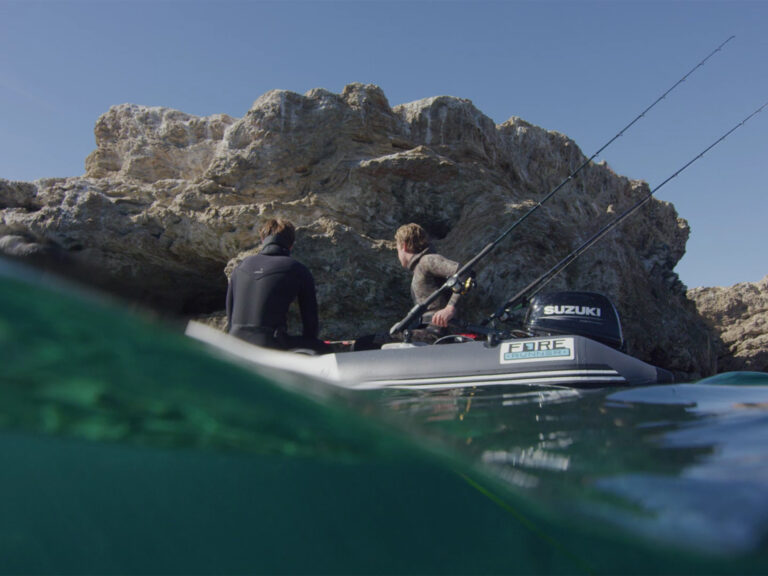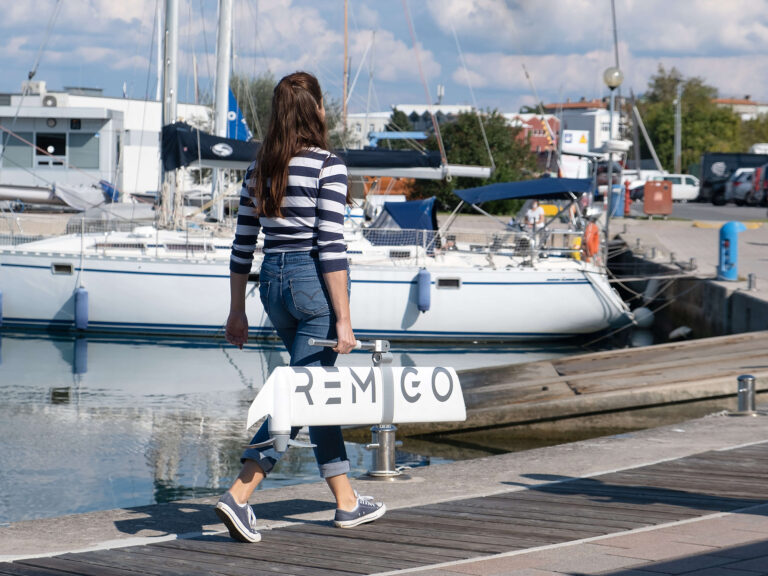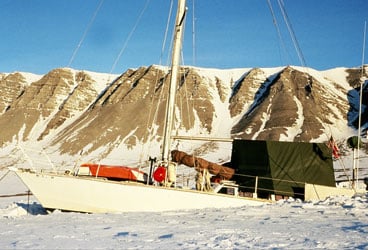
Wintering onboard
My bubba-brother from Florida flew to Maine to visit Diana and me on board our 36-foot steel cutter, Roger Henry. It was only late September, and it wasn’t particularly cold by northern standards. But we hadn’t even made the dock before my shivering sibling declared to the world that he would never, ever, venture north of the Mason-Dixon Line after Labor Day again! I pointed him to a local bumper sticker that reads “Maine: If you can’t take the winter, you don’t deserve
the summer.”
Diana and I have wintered on board from as far south as Cape Horn to north of Canada’s Baffin Island. Stranded in the white wilderness or tied to the modern amenities of a dock, we love the silent season. It’s a time to read, reflect, and enjoy slow cooking and fast friends.
But there’s no need to take winter directly on the chin. We’ve devised cold-season entry and exit strategies to mitigate the harshness on our equipment and ourselves. This process of winterizing and recommissioning a liveaboard vessel differs from that of boats that are hauled out or even from those left in the water unattended.
Positioning the vessel safely is our first concern. Even in ice-free harbors, swinging at anchor or on a mooring can expose the crew to frigid and potentially dangerous commutes to shore. Except in extremely protected harbors, I highly recommend wintering dockside.
But even dockside, when blustery winds sweep icy docks, the chances of falling into the water are high; the chances of surviving it if you can’t get out immediately aren’t. Especially in areas of extreme tides, floating docks are far safer than fixed docks. In either case, fasten nonskid materials to the dock, ladder, and rails. I lay wooden slats across the deck at the lifeline gates and in the cockpit, which allows us to wear aggressive nonskid devices, such as Yactraxs, without damaging the decks or grates.
The shock of instant immersion in ice water renders our brains useless; one must act on instinct. Dangle one bright safety line from the boat and one from the dock. Even the lowest dock is hard to climb up on from the water once your muscles are frozen into inactivity. Identify and mark the nearest exit ladder, which on a stationary pier should extend down into the water at even the lowest tide.
To prevent death-defying leaps, I secure the boat tightly to the floating dock with what I believe to be robust lines and adequate anti-chafe gear—and then I double them.
Most mountaineering stores sell small, high-tensile-plastic shovels that fit into narrow gangways but won’t chip paint or gouge fiberglass. I regularly clear away heavy snow to prevent potentially dangerous instability, but I always leave some snow everywhere, except at the entry, to act as an insulator.
Extreme cold makes most materials, but especially plastics, brittle. My sturdiest boat bucket ended an Arctic winter as a pile of shards. I now wrap the radar dome and GPS antennas with foam and cloth. I remove the plastic cone from the center of the wind generator and tie the body off in a way that allows it to rotate to the wind but prevents the blades from turning. I remove our Aqua Signal masthead tricolor light and cap the connections. For fixed masthead lights, a small canvas cover will reduce winter wear. Veteran Alaskan sailors go so far as to remove the Windex and speed instruments and install a “wire brush” lightning dissipater—more to keep the eagles off their masthead than to prevent lightning strikes.
During a period of extreme cold in the Arctic, four out of four of my stainless-steel knives shattered like glass. Fortunately, I’d loosened the standing rigging just enough to allow for contraction, which is what did my knives in, and to lessen the high-pitched vibration caused by the incessant winter gales.
Because of the increased smog and soot associated with winter, we strike and stow all sails to protect them. I’ve seen several boats with their jib and in-mast roller-furlers wrapped in plastic and taped to keep winter grit out of the delicate mechanisms.
I leave our dodger up in spite of the wear because it helps keep the main hatch clear of snow, and the clear plastic, when folded, is prone to cracking in the extreme cold. I collapse and cover the bimini, though, and lash that bundle to the aft rail.
Seldom have I seen a tarp not specifically designed to conform to the shapes and fastening points of a yacht last through even the first gale, much less an entire winter. All coverings must be strong and taut and present low profiles to winter winds.
I tie a knot in the external end of the halyards and run the knots up to the masthead to prevent the incessant clanging in the stiff breeze. As I have mast steps, these are simple to retrieve, but for those boats without steps, send a thin messenger line up with the halyards for easy retrieval in the spring.
Spade and keel-hung rudders usually lay deep enough to avoid problems with all but the thickest of pack ice. However, Roger Henry has a transom-hung rudder that’s exposed to any mischievous bit of ice that happens by. I firmly lash the tiller in place to prevent any movement of the rudder. To ensure that the rudder can’t be lifted off, I’ve installed especially thick retainer pins in the pintles.
If you anticipate substantial ice thickness, pull and plug your paddle-wheel speed transducers, if the model allows this. Self-steering servo rudders should be flipped up or removed.
Due to cooking, heating, and even just breathing down below, warm, moist air constantly comes into contact with cold surfaces. This results in an alarming amount of condensation. Diana glazes all but one of the portholes and deadlights with an insulating layer of heavy plastic, which allows welcome sunlight in but minimizes condensation. Nevertheless, she packs our clothing, extra bedding, and all small electronic devices into heavy-duty resealable bags.
She leaves the small galley hatch unglazed so that she can open it to vent the cabin when we’re cooking. This cuts down on condensation and the buildup of odors in a confined space, but more important, it ensures that an adequate supply of fresh air is pulled below. This is critical because our main hatch is designed to be so watertight as to be nearly airtight.
While some sailboat heaters use what’s called a balanced system, in which outside air is piped directly into the burning chamber, our Reflex heater burns the ambient air in the cabin. Without that proper ventilation, there’s a risk of depleting the oxygen below.
The threat of simple asphyxiation tended to, we turn our attention to that invisible, odorless, and insidious gas: carbon monoxide. While I check the flue pipe, deck fitting, and Charlie Noble on the heater for leaks or obstructions, Diana tests the carbon-monoxide detector.
Although the Reflex diesel-drip heater is efficient, I’ve placed a small fan behind the flue pipe to increase its effectiveness. This draws mere milliamps yet generates enough airflow to heat and dry the entire boat equally.
When we winter dockside, we plug in a high-quality electric space heater. I place it on a low, flat surface so that even the wildest wake can’t topple it, ensure that it’s pointed into a wide, open space, and clean the dust buildup from the rear intake regularly, as this can collect into sufficient tinder to start a fire. I set the adjustable thermostat to 45 F, which allows us to leave the boat for several days without fear of freezing the canned and bottled foods, water tanks, or interior plumbing and be able to reheat the interior to a comfortable temperature fairly quickly upon our return.
I keep the water tank only three-quarters full to protect it from overexpansion if the contents inadvertently freeze. Conversely, I try to keep the diesel tank as full as possible to protect it from condensation.
Naturally, through-hull fittings below the waterline deserve special attention. For our year in the high Arctic, I installed heavy-duty bronze seacocks. However, once we were in less extreme conditions, I replaced them with Marelon ball valves and have had no problems despite several severe winters. Of course, all underwater fittings and hoses require periodic inspection. I prefer T-bolt hose clamps, usually found on exhaust hoses, to the more common perforated worm-screw type. The T-bolts offer an increased area of compression spread equally over the entire circumference of a hose and can withstand more torque when tightening.
If we’ve established with certainty that we won’t need the engine, I take off the raw-water intake hose, immerse it in a bucket of non-toxic antifreeze, and run the engine long enough to fill the heat-exchange chamber, the exhaust lift box, and the side-exhaust swan neck with antifreeze. While the engine is running I inject fogging oil into the air intake. Once the engine is shut down I tape off the air intake port to minimize condensation within the engine. I then change the oil and filters to reduce the acidic wear of aged oil.
Water trapped inside the shaft’s packing gland can conceivably freeze, expand, and warp the gland or even burst the connection to the stern tube. Old-fashioned bronze glands are generally very robust and, once tightened down, require only occasional inspection. However, to prevent water ingress, modern dripless glands rely on one smooth doughnut connected to the propeller shaft and compressing against a smoothly lapped carbon or plastic surface on the stern tube. The pressure at which these surfaces meet is usually just enough to prevent water from entering but not enough to cause undo friction, heat, and ultimately wear. I loosen the grub screws on the shaft doughnut and slide it aft, thus increasing the spring tension on the stern-tube bellow. After I refasten the grub screw, I note in bold script in the logbook that I must remember to move this back to its marked original position before any motoring occurs in the spring.
Once a month Diana fires up and warms up all the electronic equipment to drive out any moisture and exercise the magnetron in our radar.
Our spring refit isn’t as extensive as ones for boats that’ve been laid up. Still, we have to recommission the engine, adjust the packing gland, bend the sails, refit all running rigging, wash winter grit out of all the blocks, sheaves, and tracks, service the winches, unwrap the radar, free the wind generator, remove and clean the heater flue, cap the deck fitting, pull the glazing from the ports, exchange our seasonal clothing for others in our plastic stowage bags, and mop out the condensation from the bilge.
I execute a proper load test on the ship’s batteries assuming that our continuous use has depleted their limited lifetime cycles.
Marine growth is noticeably dampened by winter’s cold water, so little working life is taken out of the antifouling paint. However, a winter in an electrically active harbor usually requires a change of zincs, and this is a good time to don a wetsuit and check the antifouling paint, cutlass-bearing wear, the pintles and gudgeons, and the raw-water intake screens, clean the transducers, and regrease the folding or feathering propeller.
The free life afloat isn’t exactly free, but winter rates for a slip are usually considerably less than the summer fare. And improved cellphone coverage and wireless Internet access have solved the problem of connectivity. One can conduct a modern yet affordable life from the comfort of their boat-home.
But more important, wintering over means that the familiarity and strong emotional connection between a sailor and his or her boat isn’t severed every six months. When our ships become our homes, sailing becomes more than a sport: It becomes a lifestyle, one that’s challenging but richly rewarding. And I’ll cross that Mason-Dixon Line any old time for that, singing “Let it snow, let it snow, let it snow.”
Alvah Simon and his wife, Diana, are CW_ contributing editors. They recently wintered over aboard_ Roger Henry_ in Alaska and the Pacific Northwest._

